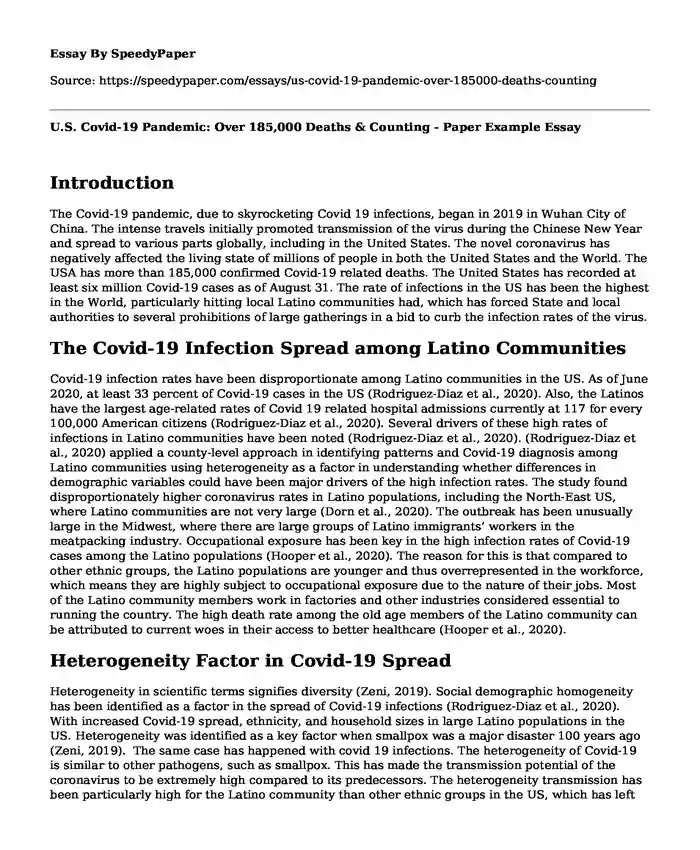
| Type of paper: | Essay |
| Categories: | Medicine Healthcare Covid 19 |
| Pages: | 3 |
| Wordcount: | 739 words |
Introduction
The Covid-19 pandemic, due to skyrocketing Covid 19 infections, began in 2019 in Wuhan City of China. The intense travels initially promoted transmission of the virus during the Chinese New Year and spread to various parts globally, including in the United States. The novel coronavirus has negatively affected the living state of millions of people in both the United States and the World. The USA has more than 185,000 confirmed Covid-19 related deaths. The United States has recorded at least six million Covid-19 cases as of August 31. The rate of infections in the US has been the highest in the World, particularly hitting local Latino communities had, which has forced State and local authorities to several prohibitions of large gatherings in a bid to curb the infection rates of the virus.
The Covid-19 Infection Spread among Latino Communities
Covid-19 infection rates have been disproportionate among Latino communities in the US. As of June 2020, at least 33 percent of Covid-19 cases in the US (Rodriguez-Diaz et al., 2020). Also, the Latinos have the largest age-related rates of Covid 19 related hospital admissions currently at 117 for every 100,000 American citizens (Rodriguez-Diaz et al., 2020). Several drivers of these high rates of infections in Latino communities have been noted (Rodriguez-Diaz et al., 2020). (Rodriguez-Diaz et al., 2020) applied a county-level approach in identifying patterns and Covid-19 diagnosis among Latino communities using heterogeneity as a factor in understanding whether differences in demographic variables could have been major drivers of the high infection rates. The study found disproportionately higher coronavirus rates in Latino populations, including the North-East US, where Latino communities are not very large (Dorn et al., 2020). The outbreak has been unusually large in the Midwest, where there are large groups of Latino immigrants’ workers in the meatpacking industry. Occupational exposure has been key in the high infection rates of Covid-19 cases among the Latino populations (Hooper et al., 2020). The reason for this is that compared to other ethnic groups, the Latino populations are younger and thus overrepresented in the workforce, which means they are highly subject to occupational exposure due to the nature of their jobs. Most of the Latino community members work in factories and other industries considered essential to running the country. The high death rate among the old age members of the Latino community can be attributed to current woes in their access to better healthcare (Hooper et al., 2020).
Heterogeneity Factor in Covid-19 Spread
Heterogeneity in scientific terms signifies diversity (Zeni, 2019). Social demographic homogeneity has been identified as a factor in the spread of Covid-19 infections (Rodriguez-Diaz et al., 2020). With increased Covid-19 spread, ethnicity, and household sizes in large Latino populations in the US. Heterogeneity was identified as a key factor when smallpox was a major disaster 100 years ago (Zeni, 2019). The same case has happened with covid 19 infections. The heterogeneity of Covid-19 is similar to other pathogens, such as smallpox. This has made the transmission potential of the coronavirus to be extremely high compared to its predecessors. The heterogeneity transmission has been particularly high for the Latino community than other ethnic groups in the US, which has left many scientists baffled by the phenomena.
Conclusion
Latinos have traditionally lacked access to better health care because of a lack of insurance, deportation fears, and inadequate insurance coverage. The problem makes it highly likely that there could be more unreported Covid-19 cases and deaths that go unreported among the community. Another reason for the high infection rates among the community is the high occupancy density in their households, air pollution, and high prevalence of other diseases such as heart diseases.
References
Hooper, M. W., Nápoles, A. M., & Pérez-Stable, E. J. (2020). COVID-19 and racial/ethnicdisparities[Online] Jama.https://digitalarchive.worldfishcenter.org/handle/20.500.12348/4258
Rodriguez-Diaz, C. E., Guilamo-Ramos, V., Mena, L., Hall, E., Hermann, B., Crowley, J. S., .. & Sullivan, P. S. (2020). The risk for COVID-19 infection and death among Latinos in the United States: Examining heterogeneity in transmission dynamics[Online]. Annals of Epidemiology.https://www.sciencedirect.com/science/article/pii/S1047279720302672
Van Dorn, A., Cooney, R. E., & Sabin, M. L. (2020). COVID-19 exacerbating inequalities in the US[Online]. Lancet (London, England), 395(10232), 1243.https://www.ncbi.nlm.nih.gov/pmc/articles/PMC7162639/
Zeni, M. B. (2019). Principles of Epidemiology for Advanced Nursing Practice[Online]. Jones & Bartlett Learning.https://books.google.com/books?id=WxK2DwAAQBAJ&printsec=frontcover&source=gbs_ge_summary_r&cad=0#v=onepage&q&f=false
Cite this page
U.S. Covid-19 Pandemic: Over 185,000 Deaths & Counting - Paper Example. (2023, Nov 27). Retrieved from https://speedypaper.net/essays/us-covid-19-pandemic-over-185000-deaths-counting
Request Removal
If you are the original author of this essay and no longer wish to have it published on the SpeedyPaper website, please click below to request its removal:
- Advance Directive and Patient-Centered Care, Healthcare Essay Sample
- Free Essay Sample on Hydrogen Cyanide Handling and Safety Measures
- Free Essay: Impacts of Vaping
- Free Essay: The Most Important Piece From the Students' Experiences
- Free Essay Example - Market Depression
- Essay Sample on Critical Review for Behavioural Perspectives of Mental Well-being
- Plant-Protein Diets: Quality, Cost & Socio-Demographic Drivers - Annotated Bibliography
Popular categories




